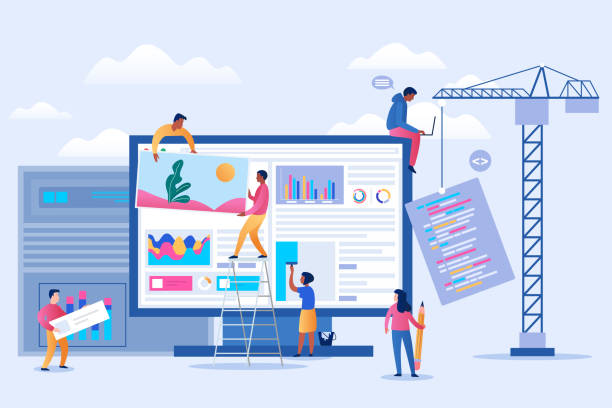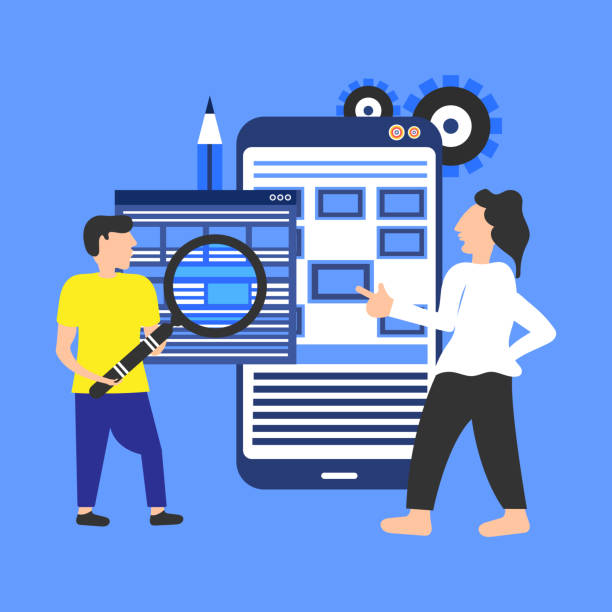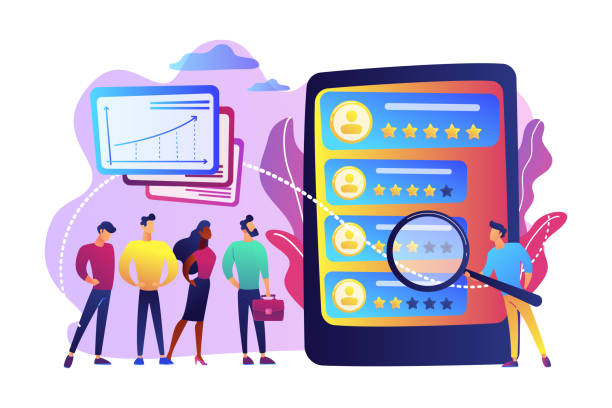Introduction to the Importance of Fast Website Design in the Digital World

In the current era where speed is paramount, the importance #Fast_Website_Design and responsiveness has become more apparent than ever.
Internet users have high expectations from websites; they do not want to wait.
Even a few seconds of delay can lead to loss of visitors, which is crucial, especially for online businesses and #E_commerce.
A fast-loading website not only improves user experience but also directly impacts search engine rankings.
Google and other search engines prefer fast websites and display them higher.
This prioritization is because search engines aim to provide the best possible experience to their users, and load speed is considered one of the key factors in this regard.
Therefore, investing in fast website design is an investment in the success and sustainability of your online business.
This concept goes beyond merely optimized coding and includes a set of strategies and techniques ranging from hosting selection to image and script optimization.
Are you concerned about your online store’s low conversion rate and not achieving your desired sales?
Rasaweb is your specialized solution for a successful online store.
✅ Significant increase in conversion rate and sales
✅ Professional and user-friendly design to attract customer satisfaction
⚡ Ready for a transformation in online sales? Get a free consultation!
Key Factors Influencing Fast Website Design and Optimal Performance

To achieve fast website design, understanding the factors affecting load speed is essential.
The first and most important factor is the quality of website coding.
Optimized, clean, and error-free codes increase browser processing speed.
Excessive use of plugins and heavy scripts (especially in content management systems like WordPress) can lead to significant slowdowns.
The next factor is the size and quality of images and multimedia files.
High-volume images without proper compression account for a significant portion of the loading time.
Furthermore, choosing the right hosting service plays a significant role in website speed.
A hosting provider with sufficient resources, high-speed servers, and ample bandwidth can make a considerable difference in site performance.
Utilizing a Content Delivery Network (CDN) can also optimize loading speed for users in different parts of the world, as content is delivered from the server closest to the user.
Caching, or temporary data storage in the user’s browser or server, is another effective method for fast website design that significantly reduces loading time for repeat visits.
Finally, database optimization, removal of unused data, and organization of information also contribute to increased speed.
These factors together complete the puzzle of a website’s speed.
Speed Analysis and Optimization Tools for Fast Website Design

To identify a website’s strengths and weaknesses in terms of speed, using performance analysis tools is crucial.
These tools help you pinpoint bottlenecks and find suitable solutions for faster website design.
One of the most well-known of these tools is Google PageSpeed Insights, which provides performance scores for desktop and mobile versions and offers suggestions for improvement.
Other tools like GTmetrix and Pingdom Tools also provide comprehensive and precise information regarding load time, page size, number of requests, and optimization recommendations.
These tools not only measure loading speed but also display technical details related to each request, helping developers accurately identify and rectify slow parts of the website.
Regular use of these tools and continuous monitoring is an integral part of the fast website design and maintenance process.
These tools often report metrics such as First Contentful Paint (FCP), Largest Contentful Paint (LCP), Cumulative Layout Shift (CLS), and Time to Interactive (TTI), all of which indicate different dimensions of user experience and load speed.
Proper understanding and interpretation of these metrics are vital for any web design team.
| Tool Name | Key Features | Main Focus | Level of Detail |
|---|---|---|---|
| Google PageSpeed Insights | Core Web Vitals scores, Google suggestions, Real User Monitoring (RUM) data | Web performance for SEO and user experience | Medium to High (with focus on metrics) |
| GTmetrix | Waterfall report, PageSpeed and YSlow scores, loading video | Deep analysis of server and front-end performance | Very High (details of each request) |
| Pingdom Tools | Load time, page size, request map, uptime tracking | Overall load speed and uptime monitoring | High (with focus on time) |
The Role of Hosting and CDN in Fast Website Design

Choosing the right hosting is one of the fundamental decisions in fast website design that is often overlooked.
The quality of the server, bandwidth, and resources allocated to your website directly impact loading speed.
Shared hosting, due to resource sharing with multiple other websites, may experience slowdowns during peak hours.
For larger or high-traffic websites, using dedicated servers, VPS, or cloud hosting is recommended, as they offer more control over resources and performance.
Alongside hosting, using a CDN (Content Delivery Network) is essential for improving fast website design, especially if your audience is scattered across the globe.
A CDN is a network of servers in different geographical locations that store your website’s static content (such as images, CSS, and JavaScript).
When a user visits your website, the content is delivered from the CDN server closest to them, which significantly reduces loading time.
This technology not only increases speed but also improves website stability and security by distributing traffic load.
Companies like Cloudflare and Akamai are among the prominent CDN providers that, with their extensive features, can greatly assist in fast website design.
Did you know that poor online store design can drive away up to 70% of your potential customers? Rasaweb transforms your sales with professional and user-friendly e-commerce website designs.
✅ Significant increase in sales and revenue
✅ Full optimization for search engines and mobile
⚡ [Get Free Consultation from Rasaweb]
Optimizing Images and Media for Fast Website Design

One of the biggest factors slowing down website speed is unoptimized images and multimedia files.
Today’s websites are full of high-quality photos and videos that, if not properly optimized, can significantly increase page size and thus elevate loading time.
For fast website design, it is necessary to save images in appropriate formats (such as WebP, which offers better compression) and compress them before uploading.
Many online tools and WordPress plugins exist for this purpose that can reduce image size without a noticeable loss in quality.
Also, using the “Lazy Load” feature for images and videos is highly effective.
With this method, images and multimedia content are loaded only when the user scrolls to the relevant section of the page, rather than all loading immediately upon page opening.
This technique greatly aids fast website design, especially for pages with long content and many images.
Furthermore, image dimensions should be proportionate to their display space on the website.
Uploading images with dimensions much larger than actually needed only leads to unnecessary size increase and reduced speed.
Clean and Optimized Coding for Fast Website Design and Superior Performance

The foundation of any fast website design is clean and optimized coding.
Cluttered, redundant, or unnecessary codes can challenge the browser’s processor and reduce loading speed.
Developers should consider the principles of “simplification and efficiency” in coding.
This includes compressing CSS, JavaScript, and HTML files, which reduces their size and consequently speeds up loading.
Removing whitespace, comments, and unnecessary code from these files also positively impacts speed.
Using JavaScript as Async or Defer for non-critical files can prevent render-blocking and improve user experience.
Additionally, database optimization, including removing redundant data, optimizing tables, and using efficient queries, plays a vital role in fast website design.
A slow database can cause problems even for a website with an optimized front-end.
Finally, reducing the number of HTTP requests by combining CSS and JavaScript files where possible (although with HTTP/2 and HTTP/3 this importance has slightly decreased) and using sprites for small images can still help improve performance.
These technical approaches are at the heart of any effort to achieve fast website design.
The Impact of User Experience (UX) on Speed and Customer Satisfaction

Website loading speed is not just a technical factor; it is deeply intertwined with user experience (UX).
A fast website keeps users satisfied, reduces bounce rate, and increases conversion rate.
When a site is slow, users quickly become frustrated and leave before the page fully loads.
This is especially critical for commercial websites, where every second of delay can mean lost sales.
Fast website design builds user trust and encourages them to spend more time on the site and interact with content or products.
Conversely, a slow website can lead to customer dissatisfaction, reduced brand loyalty, and ultimately, decreased revenue.
Studies have shown that even milliseconds of delay can affect a user’s perception of a site.
Therefore, fast website design should be considered an integral part of the UX strategy.
The ultimate goal is to provide a smooth and frictionless experience that enables users to quickly access the information they need or perform their desired actions.
This concept goes beyond merely loading content and includes form responsiveness, navigation speed, and interactivity of elements.
| UX Metric | Impact of Low Speed | Impact of High Speed |
|---|---|---|
| Bounce Rate | Significant increase (users leave the site) | Decrease (users stay longer) |
| Conversion Rate | Decrease (orders/registrations decrease) | Increase (users perform desired actions) |
| Customer Satisfaction | Dissatisfaction and negative perception | Increased satisfaction and loyalty |
| SEO Ranking | Negative impact on search results position | Positive impact and rank improvement |
Continuous Updates and Maintenance for Sustainable Fast Website Design

The process of fast website design is not a one-time task, but an ongoing effort.
Websites, like any other software, require regular maintenance and updates to preserve their performance and speed over time.
This includes updating the Content Management System (CMS), themes, and plugins.
Newer versions often include performance and security enhancements that can help maintain speed and fast website design.
Neglecting these updates can not only jeopardize site security but also gradually lead to slowdowns and incompatibilities.
Regular database cleanup, removal of spam comments and temporary files, and periodic image optimization are also maintenance tasks that should be performed routinely.
Monitoring server performance and bandwidth and ensuring your hosting can meet the website’s traffic demands are also crucial.
For larger websites, using Application Performance Monitoring (APM) tools can help identify hidden issues and prevent speed degradation before it affects users.
This proactive approach is key to maintaining fast website design and ensuring an optimal user experience.
Research shows that 80% of customers trust companies with professional websites more. Does your current website inspire this trust?
With Rasaweb’s corporate website design services, permanently solve the problem of low customer trust and poor online image!
✅ Create a professional image and increase customer trust
✅ Attract more sales leads and grow your business
⚡ Get Free Consultation
Challenges and Solutions in the Path of Fast Website Design

In the path of fast website design, numerous challenges confront developers and website owners.
One of the most common challenges is Plugin Overload, especially in content management systems like WordPress.
Each plugin loads additional code that can reduce speed.
The solution is to use only essential and reputable plugins and remove inactive or unused ones.
Another challenge is heavy images and videos, as previously mentioned; using compression tools and Lazy Load is an effective solution.
Server-related issues can also be a challenge; if the server is not properly configured or lacks sufficient resources, the site will be slow.
Upgrading the hosting plan or migrating to a higher-quality hosting provider can solve this problem.
Sometimes, render-blocking JavaScript or CSS codes can also be challenging; the solution is to load these files asynchronously or move them to the end of the page.
Lack of caching is also a common problem; correctly implementing caching mechanisms at the server and browser levels can significantly contribute to fast website design.
Identifying and resolving these challenges requires technical knowledge and continuous monitoring.
The Future of Fast Website Design and New Trends

The future of fast website design depends on technological advancements and changing user expectations.
With the advent of new technologies like 5G and improved internet bandwidth, user expectations for website speed continue to rise.
One significant trend is the progress in Google’s Core Web Vitals standards, which have introduced real user experience metrics for measuring the speed and visual stability of web pages.
Websites must be continuously optimized to pass these metrics.
Technologies like Progressive Web Apps (PWAs) also play a significant role in the future of fast website design.
PWAs offer a native-app-like experience in the browser, including offline capabilities, fast loading, and push notifications, greatly increasing speed and interactivity.
Furthermore, the development of the HTTP/3 standard, built upon the QUIC protocol, promises faster and more reliable web communications.
Artificial intelligence and machine learning can also be utilized in the future for automatic website optimization and predicting traffic patterns to ensure fast website design and stability remain at their highest level.
These new trends promise a bright future for high-speed websites.
Frequently Asked Questions
| No. | Question | Answer |
|---|---|---|
| 1 | What does fast website design mean? | Optimizing a website for fast page loading, improving user experience, and SEO ranking. |
| 2 | Why is website load speed important? | Increases user satisfaction, reduces bounce rate, improves SEO, and increases conversion rate (sales/actions). |
| 3 | What tools are available for website speed testing? | Google PageSpeed Insights, GTmetrix, Pingdom Tools are common tools. |
| 4 | What are the main factors slowing down a website? | Unoptimized images, heavy JavaScript and CSS codes, poor hosting, and lack of caching. |
| 5 | “Caching” (Caching) what is it and how does it help website speed? | Temporary storage of website data in the user’s browser or server for faster loading on subsequent visits. |
| 6 | How can images be optimized to increase website speed? | Reducing image size (compression) without significant quality loss, using modern formats (WebP), and setting appropriate dimensions. |
| 7 | What role does CDN (Content Delivery Network) play in fast website design? | Distributing website content across various servers worldwide to deliver content from the server closest to the user. |
| 8 | Does choosing appropriate hosting (web hosting) affect website speed? | Yes, quality hosting with powerful servers is essential for fast website loading. |
| 9 | What is Minification and why is it used? | Removing extra characters (whitespace, comments) from HTML, CSS, JavaScript codes to reduce file size. |
| 10 | What is the relationship between responsive design and website speed? | Responsive design means correct display on various devices; if not implemented properly, it can create extra load and reduce speed. Responsive optimization is important for speed. |
And other services of Rasa Web Advertising Agency in the field of advertising
Smart Social Media: Transform online growth with user experience customization.
Smart Social Media: An innovative service to increase customer acquisition through attractive UI design.
Smart Content Strategy: A dedicated service for growth in customer acquisition based on key page optimization.
Smart Link Building: A professional solution for analyzing customer behavior with a focus on using real data.
Smart Customer Journey Map: A fast and efficient solution for campaign management focusing on custom programming.
And over a hundred other services in the field of internet advertising, advertising consultation, and organizational solutions
Internet Advertising | Advertising Strategy | Advertorial
Sources
Importance of Website Speed in SEOIncreasing Website SpeedWebsite Performance OptimizationThe Role of Speed in Website Design
? To get your business seen and grown in the digital world, Rasaweb Afarin Digital Marketing Agency is with you. From custom website design to SEO optimization and advertising campaign management, we pave your path to success.
📍 Tehran, Mirdamad Street, next to Bank Markazi, Kazeroon Jonubi Alley, Ramin Alley, No. 6
